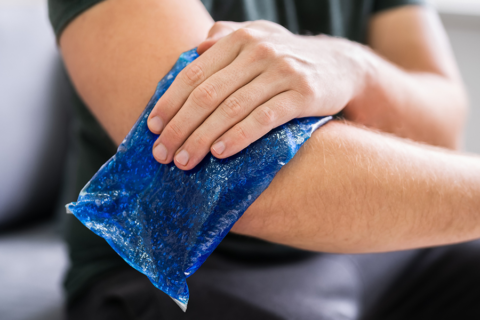1 year ago
Is Heel Pain a Sign of Cancer? When is Pain a Sign of Cancer?
Heel pain is a common ailment, often stemming from overuse or specific foot conditions. While disconcerting, it’s important to understand that heel pain is rarely the sole indicator of a serious condition like cancer. This article explores the common causes of heel pain, when persistent heel pain warrants further investigation, and in what rare cases heel pain could be a sign of cancer.
Understanding Heel Pain

Common Causes of Heel Pain be a sign.
The cause of heel pain is most often related to conditions such as plantar fasciitis or a heel spur. Plantar fasciitis, which is one of the common causes of heel pain, involves inflammation of the plantar fascia, a thick band of tissue that runs along the bottom of the foot, connecting the heel bone to the toes. A heel spur is a bony projection that can develop on the underside of the heel bone. These conditions like plantar fasciitis can cause pain, particularly in the morning or after periods of rest, and is usually localized pain.
Persistent Heel Pain: What You Need to Know Foot Pain
Persistent heel pain, especially if it doesn’t respond to typical treatments or worsens over time, needs careful consideration. While most heel pain is caused by musculoskeletal issues, neglecting persistent pain can delay the diagnosis of other underlying conditions. It’s important to differentiate between typical heel pain and concerning symptoms that might warrant further medical evaluation, as sometimes heel pain may be indicative of a more serious issue.
When is Heel Pain a Sign of Cancer?
While heel pain is rarely a symptom of cancer, there are rare cases where heel pain can be a sign of cancer. Bone pain, including in the heel, can sometimes be associated with certain types of cancer, namely:
- Bone cancer or metastatic cancer, which is cancer that has spread from another part of the body.
- Primary bone cancers like osteosarcoma, which can cause pain in the bones of the foot, including the heel.
Also, cancer that has spread to the bones, known as bone metastases, may sometimes cause heel pain. This is more likely to occur if the patient has a history of cancer.
The Link Between Heel Pain and Cancer

Exploring Cancer-Related Heel Pain
Cancer-related heel pain is an uncommon presentation, but it’s important to consider, especially when other symptoms are present or there is a history of cancer. Differentiating cancer-related heel pain from common causes of heel pain, such as plantar fasciitis or a heel spur, is crucial for accurate diagnosis and treatment. While most heel pain is caused by conditions like plantar fasciitis, cancer could sometimes cause pain that is felt in the heel bone. It’s important to recognize concerning symptoms that could suggest a more serious underlying issue, as these can be linked to cancer in rare cases.
Specific Cancers Associated with Heel Pain
While heel pain is rarely a symptom of cancer, certain cancers may, in rare cases, cause heel pain. Primary bone cancers, such as osteosarcoma originating in the foot and ankle, can cause bone pain, including in the heel. Metastatic cancer, or cancer that has spread from other parts of the body, can also result in bone metastases, affecting the bones of the foot and ankle and causing pain. Lung cancer, for example, can sometimes metastasize to the bones, including those in the foot, leading to heel pain. However, such occurrences are relatively rare, making it crucial to consider the context of the patient’s overall health as well as mental Health and history of cancer.
Symptoms to Watch For: Is Your Heel Pain a Sign?
It’s important to be aware of symptoms that, when coupled with persistent heel pain, might suggest that the heel pain could be a sign of cancer. Worsening heel pain that does not respond to typical treatments, such as rest, ice, and physical therapy, warrants further investigation. You should also be attentive to these additional symptoms:
- Unexplained weight loss
- Fatigue
- Night sweats
- A history of cancer
If you’re experiencing persistent pain in the heel and you have any of these concerning symptoms, consult a healthcare professional to determine the cause of your heel pain and rule out any underlying serious condition like cancer. While it’s unlikely that heel pain is caused by cancer, early detection and accurate diagnosis are essential.
Getting the Right Care for Heel Pain

When to Seek Medical Attention
When should you worry about heel pain? Recognizing when to seek medical attention for heel pain is essential for accurate diagnosis and effective management. While many instances of heel pain resolve with self-care measures, certain concerning symptoms warrant prompt evaluation by a healthcare professional. If your heel pain is severe, persistent, or progressively worsening despite home treatments, it’s crucial to seek medical and mental health advice.
Additionally, if you have a history of cancer, any new or unexplained pain, including heel pain, should be promptly evaluated to rule out bone metastases or other cancer-related causes. If you have concerning symptoms that may be linked to cancer, consult a healthcare professional.
Diagnostic Approaches for Heel Pain
Pinpointing the cause of heel pain often involves a combination of physical examination, review of medical history, and, in some cases, imaging studies. A healthcare provider will assess the location, intensity, and characteristics of the pain, as well as any associated symptoms. The doctor may want to explore your past history of cancer. X-rays can help visualize the bones of the foot and ankle to identify heel spurs, fractures, or other structural abnormalities. In some cases, an MRI may be necessary to evaluate soft tissues like the plantar fascia or to rule out other potential causes of heel pain, such as nerve compression or tumors.
Managing Heel Pain: Treatment Options
Heel pain management usually involves a mix of strategies, from simple at-home care to more complex treatments. Many people find relief through conservative methods, which can include:
- Rest, ice, compression, and elevation (RICE) to manage inflammation and pain.
- Over-the-counter pain relievers like ibuprofen or naproxen to ease discomfort.
- Stretching exercises with Physical Health, focusing on the plantar fascia and Achilles tendon, to improve flexibility.
- Orthotics, such as heel cups or arch supports, for added support and reduced heel pressure.
If these approaches don’t help, other treatments, like injections, might be considered.
Facebook
Instagram
Whatsapp
Youtube
Latest News
Is Heel Pain a Sign of Cancer
COVID-19 Data Tracker – Centers for Disease Control
Bedlington Terrier Infectious Disease Care and Health
September 14, 2024 0
Nutrition
Evolving Science Changes the Way We Talk about Weight Loss
August 28, 2024 0
Physical Therapy
The Benefits of Alternating Ice and Heat: A Guide to Effective Therapy
Gluten-free Bread that Tastes Good? What I Learned from Trying Every Loaf
August 23, 2024 0
You might also like
Is Heel Pain a Sign of Cancer
COVID-19 Data Tracker – Centers for Disease Control
Bedlington Terrier Infectious Disease Care and Health
September 14, 2024 0

Nutrition
Evolving Science Changes the Way We Talk about Weight Loss
August 28, 2024 0

Physical Therapy
The Benefits of Alternating Ice and Heat: A Guide to Effective Therapy
Gluten-free Bread that Tastes Good? What I Learned from Trying Every Loaf
9 Home Remedies Backed by Science
Effects of a Low Carbohydrate Diet on Energy Expenditure During Weight Loss Keeping
What is the Difference Between Vegan and Vegetarian? | Better Health Channel
Best Banana Bread Recipes and Baking Guide | Health Wellbeing
Best Superfoods to Boost a Healthy Diet
Pilates vs Yoga: What’s the Better Workout?
A 7-Day Gym Workout Routine To Help Meet Your Fitness Goals
Understanding the Power of Intrinsic Motivation
Performance Enhancing Drugs: Know the Risks
August 6, 2024 0














